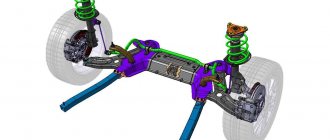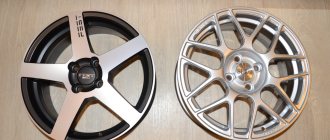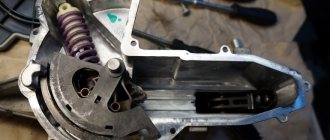While the press was thundering about Bo Andersson's resignation, trying to analyze whether he had done more good or bad, our technicians were lost in service. For a detailed analysis, we purchased the main creation of AvtoVAZ in recent years - the flagship and star of the company Lada Vesta. It was very interesting to see what was hidden inside our main threat to foreign cars. So, let's sort it out.
For “experiments,” a car was purchased, from our point of view, in the most optimal Comfort version, with a 1.6-liter VAZ engine (not yet sold with other Vestas) and a 5-speed manual transmission. We made the choice in favor of the latter after our comparative test drive of Vesta with the AMT “robot”, which, alas, still falls far short of the comfort of a classic “automatic”, although it beats it in price.
By the way, about the price. The cost of the purchased car (with a minimum set of all the options needed today) was 550,000 rubles, taking into account the discount. This is somewhere between 55,000 and 90,000 rubles cheaper than all comparable foreign rivals with approximately the same list of equipment.
Engine: VAZ brand, made in Russia
Under the hood of the Lada Vesta there is a 1.6-liter 16-valve naturally aspirated 4-cylinder engine. Power - 106 hp. With. at 5800 rpm, torque - 148 Nm at 4200 rpm. Compliance with Euro-5 standards. The engine received the marking 21129, although the designation 21126 is clearly visible on the block itself. There is no need to be surprised, since all modifications of the engine (126/127/129), which trace its history back to Priora, have a single block.
Features: original suspension system and attachments; the intake and exhaust system has been changed; adaptation for the installation of a Renault gearbox, as well as about 20 other innovations, including a lightweight connecting rod and piston group made in Tolyatti by Federal Mogul.
A test drive of Vesta showed that the engine has very good output and elasticity, but is a little noisy at high speeds.
The engine fits right into the engine compartment of the Vesta. Access to all attachments is extremely limited. The entire engine is literally shrouded in wires - during the disassembly process I had to disconnect about 40 connectors and, with some difficulty, pick out a whole bag of fasteners.
The oil filter (Avtoagregat, Russia) is sandwiched between the subframe and the exhaust manifold, and it is not protected from the latter by any heat shield, which raises some concerns. The drive belt and its tension pulley practically rest against the inside of the body, just like the timing mechanism, so replacing them is only possible with a complete disassembly of the front right side of the car, dismantling the right additional side member and hanging the engine.
The officials confirmed to us other information that we suspected, but did not check ourselves. Due to the fastening features, removal of the engine sump (crankcase) is only possible with the removal of the gearbox.
Options [ edit | edit code]
LADA Vesta has three main configurations - basic Classic, medium Comfort and top Luxe. The sedan is also available in a simplified Standard package and a top-end Exclusive package. All trim levels have options. For the Classic package - Start, for Comfort - Multimedia and Image, for Luxe - Multimedia and Prestige. Modifications:
- Vesta Cross is a passenger 5-seater off-road sedan.
- Vesta CNG is a modification that allows the use of two types of fuel: compressed natural gas (methane) and gasoline.
- Vesta SW is a 5-seater station wagon.
- Vesta SW Cross is a passenger 5-seater all-terrain station wagon.
- Vesta SW Sport is a sports passenger 5-seater station wagon.
- Vesta Sport is a 5-seater passenger sedan with original bumpers, “skirts” on the sills and a spoiler on the trunk lid. The car is equipped with a forced 1.8-liter VAZ-21179 gasoline engine, which is paired with a 5-speed MT Renault. Engine power is 145 hp. s., torque 184 Nm, and top speed 193 km/h [12]. The official premiere took place at the Moscow International Motor Show on August 29, 2018 at the Crocus Expo complex, and sales began on January 31, 2019.
At first, this car appeared under the name Lada B. A little later it received a traditional index - VAZ-2180 or Lada 2180. Then it began to be positioned as the successor to the Priora. And just recently the official name of the new model of the Volga Automobile Plant was announced - Lada Vesta.
LADA > Vesta
With the arrival of Swede Bo Andersson as General Director of AVTOVAZ, the enterprise development program for the period until 2021 had to be revised again. The changes affected mainly the model range of the Lada brand. The main stages are clearly demonstrated in the table. It makes sense to pay attention to the last of the cars presented in it. The fate of a full-fledged golf-class sedan under the Lada brand literally hung in the balance - the Gazov Varangian intended to sequester the program specifically for this model in order to reduce costs. But, having seen the finished model of the new product in the “Greek” hall, he changed his mind - he liked the car.
Gearbox: Renault brand, made in Russia
The Lada Vesta is equipped with a French 5-speed manual transmission JH3-510. The transmission housing is cast at VAZ's own metallurgy. Actually, all assembly is carried out in Tolyatti.
The choice in favor of a foreign gearbox was made due to the fact that in the native VAZ engineers were unable to overcome extraneous noise, in particular the hum of gears. It is known that the French gearbox costs AvtoVAZ 20% more than the domestic one.
Let us recall that the AMT “robot” was created on the basis of a domestic gearbox, in which the problem of noise (in particular, a muffled howl in second gear) is still relevant. We have no complaints about the performance characteristics of a manual transmission.
Lada Vesta Sport
Lada Vesta Sport The most sporty and powerful car in the model range of the Togliatti concern should be the Lada Vesta Sport.
The first sample was presented at the Moscow Motor Show in 2021. According to preliminary data, the sports car will be equipped with an engine developing 150 horsepower. The appearance will retain the X-shaped style of the Lada Vesta generation. A more aggressive design will appear, highlighted by bright color accents and a lower ground clearance of 135 mm. The release of the first civilian sports sedans is scheduled for the end of 2021. Their cost will be at least one million rubles.
Radiators (cooling, heating, air conditioning systems): Valeo brand, made in Russia
All three Vesta radiators from the French brand Valeo (a well-known component manufacturer) are distinguished by good workmanship, in no way inferior to their world analogues. During dismantling, it was difficult to suspect that the radiators were assembled in Tolyatti at Valeo’s own production site.
By the way, the competence of the employees of the hotline of the Russian representative office of Valeo (where we were transferred to answer questions) was called into question. They couldn’t say exactly what was being assembled at the Valeo site in Nizhny Novgorod, and when asked about production in Togliatti, we were told that there was no confidence that it was working at all, although the press service of AvtoVAZ firmly confirmed the opposite.
Generator: Valeo brand, made in Türkiye
The generator of the same French brand Valeo, but already made in Turkey, confused us at first - instead of the usual orange transformer varnish, the windings are covered with protection that is not uniform in color. However, as they say, “the speed should not be affected.” But we consider the fact that the terminals from the winding were not soldered, but simply crimped, to be a disadvantage. Not durable.
In addition, dismantling the component (replacement) is extremely difficult due to its location. The generator is clamped by the air conditioning compressor from below and its tubes - from the end and from the top, and from the belt drive side, as well as the tension roller, by the wall of the engine compartment. As a result, when replacing the generator, you will have to remove the air conditioning compressor (if there is one, of course).
Three more Valeo components found: starter (Poland), release bearing and climate control unit (Czech Republic). The French company is one of the world's main manufacturers and suppliers of components for car factories, including, of course, fellow countrymen from Renault, from whom it migrated to AvtoVAZ.
Where do legs grow from?
The XRAY concept car (translated as “X-ray radiation”), demonstrated at the end of August 2012 at the Moscow Motor Show, set the foundations for the future style of all VAZ models. At least for the next five years. And we are talking not only about the elements of the external design of cars, but also about their interiors. Of course, they are unlikely to completely replicate the interior of the concept, but they will certainly retain some elements of its design. In particular, the shape of the steering wheel will probably be embodied in production cars, and it cannot be ruled out that the center console will be truncated.
Fuse box and its housing: Renault brand, made in Romania
The fuse box comes entirely from the Logan model, as evidenced by the Renault logos on the body and the Romanian manufacturer Capirom. True, AvtoVAZ reported that in the near future the company will change its supplier to a local one - from the Samara region.
We had no questions about the unit itself, but in the process of a scrupulous study by the electricians, a very interesting point emerged. Attention was drawn to two fuses that were not indicated either on the diagram or in the instructions. A study of the electrical circuit revealed that during a sudden voltage surge (for example, when lighting up a Vesta with the engine running), these fuses may burn out, resulting in the battery stopping charging. And what’s most insidious is that the driver of a discharged car will not know about it - no electrical “paths” to the dashboard (indicator lamps) could be found. Whether the reason will be revealed when connecting the standard diagnostic system in the absence of an error that pops up is also a question.
The controls also turned out to be imported - the steering rack is from the famous German brand ZF, but made in Malaysia. And the CV joints are provided by the British company GKN and made in Poland.
The Lada B platform, which underlies Vesta, is almost entirely a domestic development
It is on this that the new AVTOVAZ model is based. The platform incorporates the experience of several developments at once. Here are the current Priora, and the defunct “Project C”, and elements of the Franco-Japanese B0 (Logan, Almera, Largus).
Last year’s publication mentioned a 1.8-liter engine developed as part of the same “Project C” as a potential power unit. Now it’s difficult to say how real his appearance will be. Based on current trends towards reducing fuel consumption and improving environmental friendliness, it is more likely that a supercharged unit will appear in the range. And, according to some information, VAZ motorists are developing it together with the Ricardo company. The 1.4-liter engine will produce 150 hp. power and 240 Nm of torque.
Brakes: TRW brand, made in the Czech Republic, Poland, Italy, France, Turkey
In order for the Lada Vesta to stop properly, manufacturers from almost half of Europe had to work hard. In total, we counted five countries producing the braking system, including French SNR bearings pressed into the rear brake drums (integrated with the hub) of the German ATE brand, but of Italian production. When it is necessary to replace the bearing, it will be extremely difficult to remove it separately - most likely, you will have to change the entire assembly. Although the name of the SNR brand, which is premium by the standards of the world of auto components, inspires hope for durability.
So, the brake master cylinder and vacuum booster came from Poland, the front calipers and pads came from the Czech Republic. Some of the brake hoses turned out to be made in Turkey by Teklas. One of the features is that there is one brake system reservoir for two with a clutch drive.
The only question regarding the brakes arose when considering the front pads, on which there was a working mark of the cylinder - a quarter of the pressing surface extends beyond the pads. It is difficult to say whether this somehow affects the braking efficiency. While driving, we had no complaints about the braking system.
You will also have to tinker with the suspension elements during repairs. According to “foreign” patterns, the ball (produced by the BelMag Magnitogorsk plant) comes assembled with a lever. Moreover, replacing a component will require a lot of additional actions to free up space around it. By the way, according to servicemen, play of ball joints and knocking of stabilizer struts are the most frequent complaints from the first owners of Vesta.
Shock absorbers are one of the few Vesta components on which we did not see the “Aglitsky language”. The racks were produced at the Skopinsky Automotive Assembly Plant in the Ryazan region. By the way, in terms of the balance of suspension characteristics, we recognize Vesta as one of the best in the class.
We saw the only “Made in China” inscription on the windshield wiper motor from Bosch, with the logos of another automaker - the Chinese company Chery
Lada Vesta Signature
Lada Vesta Signature The longest car in the VAZ model range was the Signature version for VIP clients.
Initially, the model was developed to equip the fleet of state government agencies at the regional level. The emphasis was placed on comfortable placement of second-row passengers. Having received a body lengthening of 25 cm, the Lada Vesta Signature has remained almost unchanged in appearance. With the naked eye, you can distinguish it from a regular Vesta only from the side by the enlarged rear door. At the back of the car appeared the inscription “Signature”, made in the handwriting of Steve Mattin, the chief designer of the Lada Vesta. The design of the car remains the same. The long version will be equipped with a 122-horsepower engine. The suspension has received minor modifications.
The main changes affected the interior of the new product. The premium sedan of the VAZ model range received new interior finishing materials. Now the seats and steering wheel are trimmed with leather inserts, the ceiling is covered with Alcantara, and the rear sofa has turned into two separate luxurious armchairs, separated by a solid armrest. The climate control and heated seats for second-row passengers are controlled by buttons located on the armrest.
Interesting!
The very first long sedan was assembled for the former AvtoVAZ president Bo Andersson as an official vehicle.
The first samples of the extended version of the Lada Vesta were sent at the beginning of 2021 to the governments of the Samara and Moscow regions for testing and detection of possible deficiencies. According to preliminary data, the Signature version will be produced to order and cost about 1 million rubles.
Various plastic parts
There is already such a diversity of companies and manufacturing countries that it makes no sense to single out anyone separately, so we’ll just list them.
The air filter and its housing turned out to be from the famous German brand Mann+Hummel, and of original production. The electric fuel pump module assembly (with an Arsan pump) is Russian. The radiator expansion tank hose is from Teklas, but not from Turkey, but from Bulgaria. Washer reservoir with Renault logos, Continental washer pump, made in the Czech Republic.
With the exception of the aforementioned Czech microclimate control unit, the plastic interior parts turned out to be Russian, in particular Izhevsk. Moreover, the quality of fastening (hence the country of production) of individual small parts could be determined by touch - they were either loose or fell out at the slightest touch.
There was also a Russian approach: the plastic frame of the gear lever (Italian-Russian company AE2) that was not “shrunken” was sharpened on the inside (apparently with a file) along the edge. The side plug of the front panel (on the side of the front right door) bounced off like a spring at the first attempt to snap it off (what voltage was it installed under?).
Taking into account some other flaws in the interior assembly in the form of naked screws and gaps, it is worth saying that the interior of the Lada Vesta is generally better assembled than can be expected from most modern Ladas, but it is felt that over time, part of it will traditionally “come to life”. By the way, at first glance we liked the interior assembly of the almost entirely imported Lada XRAY more.
Some time ago, the Avtostat agency published the full list of component suppliers - there are also a dozen foreign brands that we have not mentioned. Some of them, by the way, did not coincide with the real ones - in particular, the tires on our Vesta were Pirelli, not Continental.
Lada Vesta
As we know, the design of modern Ladas is carried out by the Briton Steve Mattin, who gained fame as a stylist at the German Daimler and the Swedish Volvo. Mattin got down to business without much hesitation and in the fall of 2012 demonstrated his vision of future VAZ models. The concept called XRAY was received with a bang, and after some time it was decided to implement the ideas contained in it in future models of the domestic brand. The first-born of the new style should be Vesta. If we look again at the table given here, we can see that we need to wait for the appearance of a production car closer to the fall of next year (2016 was originally announced). But it cannot be ruled out that this August we will be able to see a pre-production copy of Vesta at the Moscow Motor Show.
Read also: How to turn off the siren on a Starline alarm system
How the body is made
Let's admit: the Lada Vesta, which is attractive in our opinion, is very well assembled in terms of its bodywork. The measured gaps are everywhere at the level of a couple of millimeters. Well, the softness and silence with which the doors close are completely worthy of applause. And everything would be absolutely wonderful if we had not started studying the car from below.
In general, of course, there is no “crime”. The first thing that caught my eye was the sloppiness of the anti-corrosion treatment, in the category of “we’ll apply it here, but it’ll do just fine.” It can be seen that some areas were treated over the protective film, which was then torn off along with the protection. Moreover, in the same place it was done with completely different quality (carefully and clumsily).
An incident was discovered under the hood - at the factory, a piece of paper was attached to one of the side members with tape, apparently with an example of a color called “platinum”, in which it was necessary to paint the car from the inside. Actually, they painted this piece of paper, forgetting to tear it off - naturally, there was a stripe under it without painting.
The rear beam mounts, apparently, are not original. One of the “ears” for the bolts was left protruding into the wheel arch.
Another point is the accuracy of internal bends and connections of individual body parts. Between some of them there are considerable technological holes into which, of course, dirt, salt and road chemicals will get clogged. Considering that some of these connections have not been exposed to anticorrosive agents, they are likely to become centers of corrosion, especially in the wheel arches.
For the purity of the experiment, we looked under the bottom of the first Vesta competitor we came across - the Skoda Rapid liftback (in the database from 539,000 rubles). It has an armor-piercing shield underneath, wrapped in treatment without a single crack or stain, and even with two plastic sheets of protection on top.
The findings are mixed. The main one is that in terms of quality and level of assembly, Lada Vesta is probably the best car among the products of our automobile industry, at least in modern history. However, a large number of annoying and minor “jambs” do not yet allow our sedan to catch up with Western competitors, and at a comparable price.
The second conclusion is that calling Vesta domestic, having broken it down into spare parts, is hard to come by. Especially if you remember that even those branded components that are produced in Russia are made on imported machines, using imported raw materials.
Well, the third conclusion: you can forget about any Vesta service outside of professional service. At the dacha you can only change the brake pads and pump up the tires yourself. Apparently, this is also why car sales in the regions turned out to be worse than expected. In general, we will now keep an eye on our ward and be sure to inform you about all the joys and hardships.
Popular sedan
Lada Vesta in a classic four-door design has already managed to win the popular love of Russian car enthusiasts. The modern appearance and generous equipment of the new product immediately attracted increased attention to the car. The sedan body combines the practicality of a family car, dynamism for young people and reliability for older people.
Lada Vesta in the classic version
On a note!
The dimensions of the sedan correspond to the dimensions of a class B car. The length of the body is 4410 mm, the width of the Lada Vesta is 1764 mm, and the height is 1497. The advantage of the sedan over many of its classmates is its significant ground clearance of 178 mm.
The configurations are presented in three main levels of equipment: Classic, Comfort and Luxury. Additionally, each version can be equipped with the Start, Image and Multimedia option packages. The basic Lada Vesta is already equipped with all the necessary security systems:
- ABS+BAS, ESC, TCS, EBD, HSA systems;
- two airbags;
- belts with pretensioners;
- ERA-GLONASS warning system;
- engine protection;
- immobilizer and alarm system.
The starting price for the Lada Vesta in the “base” is 545 thousand rubles. The maximum equipment of a car with a top-end engine and automatic transmission will cost 715 thousand rubles.











